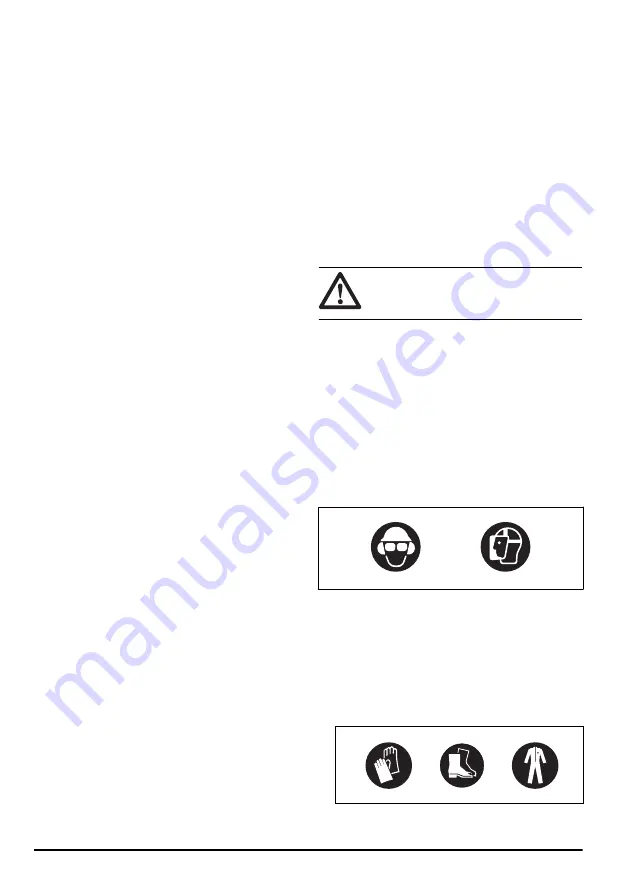
• Always stop the engine and make sure that the
cutting equipment does not rotate before you
remove material that is wound around the blade
shaft or caught between the guard and the cutting
attachment. The cutting equipment continues to
rotate even after the throttle has been released.
Ensure that the cutting attachment has stopped
completely and disconnect the spark plug cap before
you start to work on it.
• Be careful when you remove material from around
the cutting equipment. The bevel gear gets hot
during operation and can cause burn injuries.
• The exhaust fumes from the engine are hot and can
contain sparks. Risk of fire. Be careful around dry
and flammable material.
• Stop the engine before you move to a new work
area. Always attach the transport guard before you
move the equipment.
• Never use the product indoors or in spaces lacking
proper ventilation. Exhaust fumes contain carbon
monoxide, an odourless, poisonous and highly
dangerous ga can result in death due to asphyxiation
or carbon monoxide poisoning.
• Never allow children to use or be in the vicinity
of the product. As the product is equipped with a
spring-loaded stop switch and can be started by low
speed and force on the starter handle, even small
children under some circumstances can produce the
force necessary to start the product. This can mean
a risk of serious personal injury. Therefore remove
the spark plug cap when the product is not under
close supervision.
• Overexposure to vibration can lead to circulatory
damage or nerve damage in persons who have
poor circulation. Speak to your physician if you
experience symptoms of overexposure to vibration.
Such symptoms include numbness, loss of feeling,
tingling, pricking, pain, loss of strength, changes
in skin color or condition. These symptoms usually
show in the fingers, hands or wrists. The risk
increases at low temperatures.
• Check that the cutting equipment is correctly fitted
and adjusted.
• If you encounter a situation where you are uncertain
how to proceed you should ask an expert. Contact
your dealer or your service workshop.
• Avoid all usage which you consider to be beyond
your capability.
• Do not use the product unless you are able to call for
help in the event of an accident.
• Using an incorrect cutting attachment or an
incorrectly sharpened blade increases the risk of
blade thrust.
• Products fitted with saw blades or grass blades can
be thrown violently to the side when the blade comes
into contact with a fixed object. This is called blade
thrust. A blade thrust can be violent enough to cause
the product and/or operator to be propelled in any
direction, and possibly lose control of the product.
Blade thrust can occur without warning if the product
snags, stalls or binds. Blade thrust is more likely to
occur in areas where it is difficult to see the material
being cut.
• Avoid cutting with the area of the blade between the
12 o'clock and 3 o'clock positions. Because of the
speed of rotation of the blade, blade thrust can occur
if you attempt to cut thick stems with this area of the
blade.
• Mufflers fitted with catalytic converters get very
hot during use and remain so for some time after
stopping. This also applies at idle speed. Contact
can result in burns to the skin. Remember the risk of
fire.
• Only use cutting attachments with the guards we
Accessories on page 25
.
Personal protective equipment
WARNING:
Read the warning
instructions that follow before you use the
product.
• Always use approved personal protective equipment
when you use the product. Personal protective
equipment cannot fully prevent injury but it
decreases the degree of injury if an accident does
occur. Let your dealer help you select the correct
equipment.
• Use a helmet if the trees in the work area have a
height of more than 2 m/6.5 ft.
• Use approved hearing protection.
• Always use approved protective googles that comply
with ANSI Z87.1 standard in the USA or EN 166 in
EU countries.Use visor for face protection. Visor is
not enough to protect the eyes.
+
• Use gloves when it is necessary, for example when
you attach, examine or clean the cutting equipment.
• Use protective boots with steel toe-cap and non-slip
soles.
• Use clothing made of a strong fabric. Always use
heavy, long pants and long sleeves. Do not use
loose clothing that can catch on twigs and branches.
Do not use jewelry, short pants or sandals. Do not
go with bare feet. Put your hair up safely above
shoulder level.
6
975 - 005 - 14.11.2022







































